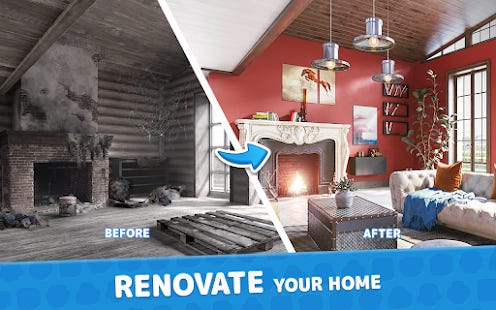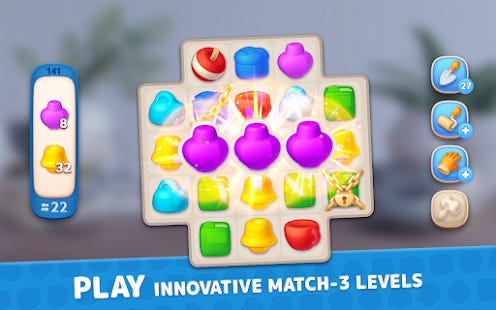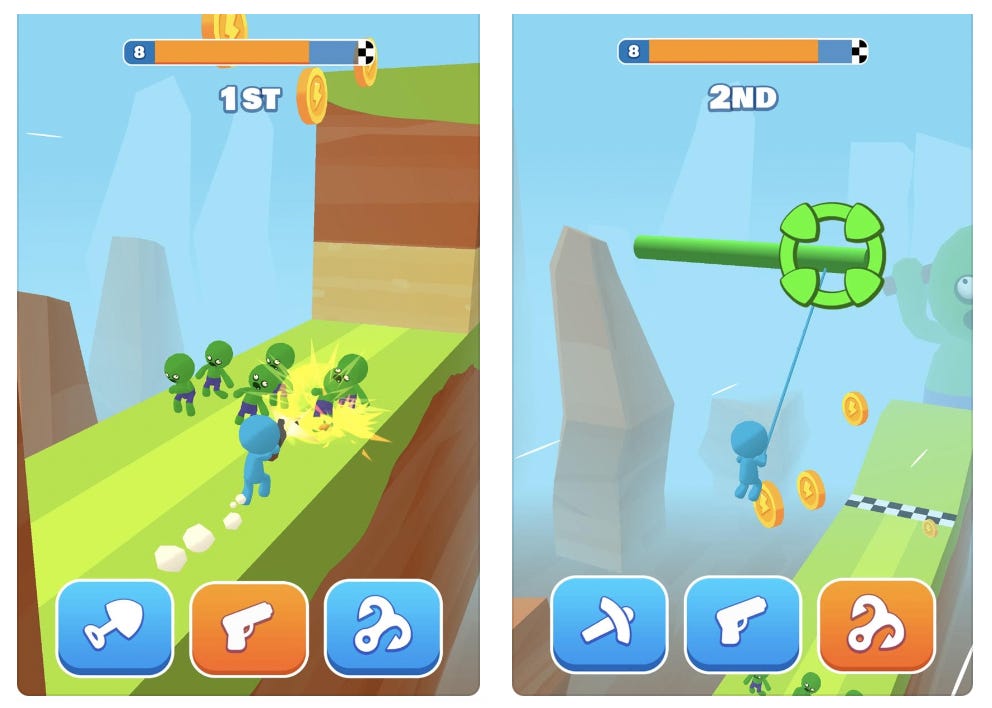Artur Davydenko Q&A: Building A Hit HybridCasual Game
Using experience from 250m hypercasual downloads.
Howdy. Martin here. 👋
Welcome to another edition of Game On!
Today I’m sharing the commercial framework Artur Davydenko, CRO of HoneyLab, is using to build and scale hybridcasual games.
Highlights:
Where he sees opportunity withn hybridcasual. 👀
How HoneyLab distributes and monetizes their games. 🧪
A critical tip for founders of new hybridcasual studios. ⚠️
To receive newsletters sharing the business and know-how behind gaming, subscribe below.👇
Let me introduce you to Artur Davydenko.
He’s the CRO at HoneyLab, a new studio innovating with hybridcasual games.
🤔 ICYDK. Hybridcasual fuses the mass-appeal and accessible core-gameplay of hypercasual games with the progressive mechanics and retention-orientated meta gameplay from casual games.
The general idea of this approach is to keep CPIs at super-low hypercasual levels whilst increasing LTV and therefore ROI.
But, it can be a tricky balancing act. Many developers are able to achieve one part of this equation well (low CPIs or higher-LTV) but struggle with both, creating scaling challenges.
Archero is often cited as an example of a hybridcasual game that nailed it.
Prior to HoneyLab, Artur flexed his gaming muscle at Google, Playgendary, EVA, and Kefir in mostly business development and project management roles.
At Playgendary, he was involved in taking numerous hit games to market:
Hitmasters (hypercasual) - 120M downloads.
Perfect Cream (hypercasual) - 100M downloads.
Escape Masters (hypercasual) - 30M installs.
Design Masters (casual) - 3M installs.
Hitmasters was recognised as the 3rd most downloaded hypercasual game globally by an EMEA-HQ'd company in Q2 2020.👇
Design Masters, a match-3 game, was featured by the Apple App Store because of its distinctive and engaging features: photorealistic interiors and captivating storyline. 👇
Much has been written about the demise, or impending ‘peak’, of the hypercasual market over the last couple of years.
Whether or not you hold views that are more towards the bullish or bearish end of the spectrum, there are a few unavoidable facts that make entering or operating in this market tougher than 1-2 years ago.
In a recent PGC piece, Master the Meta commented:
In terms of a future outlook, the fundamentals of hypercasual haven’t changed since their rise in 2017.
It continues to remain a genre with low barriers to entry, quick production cycles, mass appeal, highly sticky core gameplay, ultra-aggressive ad monetisation tactics and short product lifespans.
That leads to a hypercasual business sustaining through highly frequent new game launches, where LTV beats CPI at a massive scale.
Over the past years, these unique genre dynamics have also resulted in fierce competition, market saturation, a lack of staying power for market leaders and a growing need to innovate and differentiate to stay relevant.
On top of that, there is the IDFA elephant in the room, the impact of which continues to remain unclear for hypercasual’s ad-driven user acquisition and monetisation model.
There’s certainty around some of the data -
Hypercasual download volumes continue to grow, and
YoY download growth rates are slowing.
In other words, while hypercasual will continue to have its place in the future, it’s also a maturing genre.
With intense competition in the hypercasual market pushing user acquisition costs higher and higher, many developers and analysts understandably view hybridcasual as a huge and relatively untapped area of opportunity that can springboard out from hypercasual studios.
This is exactly the approach HoneyLab is taking, so I sat down with Artur to find out how they are tackling this from the frontlines.👇
🕹️ Q&A
Hypercasual is an ultra-competitive market today. You see an opportunity with hybridcausal. What commercial thesis and framework are you utilizing to succeed?
Yes, hypercasual CPIs have increased a lot.
It’s no longer $0.2-0.3, it's more like $0.4-0.5 CPI, which is significant when LTV for a typical hypercasual game is $0.7-0.8.
So, it’s much more difficult than it was two years ago.
A typical hypercasual game will retain players for 3-5 days in order to generate that LTV of $0.7-0.8.
Since the margins on that model are becoming strained, you now need to retain players for 7 days and yield an LTV closer to $1.
How do you go about doing that?
Adding more content and depth of gameplay.
Every studio has their own approach. We invest more in the core gameplay— skill mechanics, physics, progression satisfaction, and visual arts.
It costs more, but significantly increases retention and LTV. It’s important to find the right balance.
Specifically, we are creating hybridcasual versions of classic arcade games.
That means fusing classic arcade-style games we had ten years ago with more depth of content in terms of game and level design.
Can you share more on that?
We are focused on building runners.
It’s a game format in which you need to avoid obstacles and perform specific actions in order to get the finish. The most difficult and interesting part for a developer here is the obstacles, physics, enemies, and rules while you're running.
We’re enriching this format with exciting game actions and visually satisfying elements. Our objective is to focus on this segment for like six-twelve months, developing one to three successful games during that time.
I would love to share the game names but can’t since we’re soft-launching. But, I can share screenshots of our games to give you an idea. 👇
Awesome. Regarding these HoneyLab games, what have you focussed on, specifically, to target retention of 7 days?
We're focusing on core-loop depth & content.
Core-loop will include more small mechanics on levels, physics, and animations.
Content will include more levels, skins, and, in some cases, meta-loop mechanics like collections and builder.
If you could give one piece of advice to the founders of a new hybridcasual studio, what would it be?
You need to focus on one segment and develop a lot of models that you can reuse in the future.
For example, if you’re building an endless runner, stick to endless runners. Build the basic components (the jumper, obstacles, animations) so they are reusable.
You will spend less time in development and will be able to keep testing different endless runner concepts quickly and cost-effectively until you find your hit game.
The same goes with other genres. If you do puzzles, do just puzzles. Make your models and use them to keep testing until you find your hit game—it should take 6-12 months using this methodology.
Otherwise, it will be much longer and expensive.
Let’s talk about distribution. What is your approach to this?
We work with a publisher. They handle user acquisition in both terms of expense and operations. The vast majority of our users (90%+) come from paid distribution.
What does the economics and process of that look like for you?
In a standard non-exclusive agreement you split revenue 50/50 after their marketing costs have been deducted. If you hit 5M+ downloads, it’s possible to move over to an exclusive agreement where it’ll be more like 60/40.
Here’s what the process looks like:
Phase 1 testing - $600-$1,000 budget.
Phase 2 testing - $5,000+
Phase 3 - scale-up.
During both Phase 1 and Phase 2, the publisher will analyse one week’s worth of KPIs and will then either decide to kill testing overall or move onto the next phase. The KPIs are often CPI, CTR, Retention, and LTV.
This process is often referred to as ‘CPI testing’ within the industry, but that’s a bit misleading. Today, many KPIs are taken into consideration.
As a hypercasual or hybridcausal developer, you’re spending a lot of time in Phase 1 testing. Most games do not make it past this point. They die. It’s a numbers game.
Most of this small-scale testing is conducted via Facebook because it optimizes fast and efficiently, meaning it can discover intrinsic retention and monetization KPIs the most cost-effectively.
But, when a publisher scales user acquisition Facebook will drop to around 10% of the overall budget. The remaining 90% is mostly spent with ad networks, because CPIs are super lower by comparison. Google will be part of the mix, also.
How does geo-targeting fit into this?
We conduct testing via two distinct geo-targeted campaigns.
Campaign 1: United States.
Campaign 2: Rest of the world — weighted towards countries like Indonesia, Brazil, Russia, & Turkey. This mostly excludes Tier 1 English-speaking countries because it’s not as efficient to test in those markets. Countries like Brazil and Indonesia attract a lot of clicks and installs — they have large populations that play hypercasual games.
We have to test the United States separately since, although it will account for 10% of overall traffic in the scale-up phase, it will generate 40-45% of total revenue.
Other Tier 1 countries will collectively generate 20% of revenue, and the remainder will be the rest of the world.
Have you tried self-publishing?
Yes, at Playgendary, the previous company I worked for, we were self-publishing.
We had more than 100 employees across user acquisition, analytics, creative, etc. It was a lot of people, and combined with the actual ad budget, a significant expense.
When you’re starting from scratch as a studio, it’s much easier to use a publisher. They handle all of the risks and difficulties surrounding user acquisition.
But, you are losing a lot of margin with a publisher. So, after the first year or so, we will look to organize our own user acquisition.
Speaking of losing margin, have you thought about licensing a popular IP? For example, Spider-Man for an endless runner game?
First of all, you will have to get a license to produce 10-20 games, since you will need to make that many before you get a hit. That will be expensive and may kill unit economics.
And, you’re narrowing the scope of what you can experiment with within your core expertise hypercasual segment (e.g. endless runner). This will reduce the likelihood you even find a hit game.
Usually, it works the other way around.
For example, you already have a hit game and an agency representing a company like Marvel or Warner will approach you and ask to put a character in your game for a brief period of time. This usually happens around a major film or streaming series launch to enrich its release.
Sometimes it will be a free-IP license, sometimes they will pay for the promotion. This happens more in casual and mid-core games than hypercasual, though.
Once that promotional period has lapsed, the developer will need to pay a fee to keep the character in the game, but most don’t and just delete it.
An interesting trend I’ve seen recently is developers creating ‘look-a-like’ in-game characters from very famous IP. For example, Rick and Morty. And, Imposter from Among Us.
These in-game characters do not look *exactly* like their copyright-protected counterparts, but it’s close. Enough for players to make the connection.
It’s tricky because developers do not want to get sued, but rewarded video ads increase by 2-3x with these characters in the game.
Let’s move onto that next. What is your monetization framework?
In-App Advertising.
This has to be set up so the average advertising revenue per user exceeds their acquisition cost.
Since player retention is just a few days, this means a fairly high-frequency ad delivery experience is necessary in order to make the unit economics work. You need to show more than 20 ads over the first 1-2 days.
But, you have to balance this with ad fatigue and friction. If ads feel too interruptive or exhaustive, retention will suffer.
We managed this at Playgendary by ourselves. Now, we’re seeing how it’s done by the publisher we’re working with.
It's almost the same—we have interstitials and rewarded videos. They are integrated to load at moments that don’t interrupt gameplay. At these moments players are open to engaging with the ads since they can be tied to in-game advancement.
For example, interstitials load after each level. As do rewarded ads, which multiply rewards, unlock skins, and weapons. These enhance the overall game experience and can help you advance faster. On the main lobby, there’s a skills button. Players can watch a video ad to boost their skills.
With this approach, monetization is enormously affected by the number of levels in the game and their duration. The greater the number, and the faster players move through them, the better ad revenue will be.
In terms of ad inventory management, we use waterfall mediation.
🤔 ICYDK. Waterfall mediation is a yield optimization process that offers ad inventory for sale to demand partners (ad networks) one-by-one in a pre-defined order until there’s a taker (or not if there’s a CPM floor that doesn’t get met).
This pre-defined order is known as the ‘waterfall’ and is configured based upon historical eCPMs (from best to worst). Since this model is based on historical data, it does not guarantee the ad impression gets sold for the highest amount possible.
Ad networks towards the bottom of the waterfall, who may be prepared to pay the most for the impression, may not get the chance since it was already sold to an and network at the top.
Our waterfall mediation process mostly involves playing around with demand sources by geo and setting eCPM floors every 1-2 days.
On some days, you can set a $100.00 eCPM floor in the United States—this can increase revenue by 10 or 20%, which is great.
What about In-App Purchases? Many hybridcasual games mix IAA with IAP.
Yes, we’re going to do this with all successful releases by adding IAP-purchases step by step:
No ads purchase.
Hard currency + shop premium content.
Chests with gatcha-mechanics.
What are your thoughts on the future of hypercausal?
The industry is moving from pure hypercasual to a hybridcasual model.
Do you think the sustainability of this market is threatened by its core audience base growing fatigued with ad-heavy gameplay?
No. The core audience of hypercasual is 16 to 25.
As they get older they move onto other games. For example, mid-core.
When that happens, a new set of players move up into the 16 to 25-year-old age category. Hypercasual games can be marketed to this fresh audience.
Has Apple’s IDFA change had a material impact on your model? How have you tackled that?
CPI has increased by 20-30% on average.
So you either sacrifice margin by doing many simple prototypes OR increase the quality of content/monetization.
We chose the second approach, which the industry calls hybridcasual.
—
Thanks, Artur!
If you’d like to learn more, check out the links below.
Until next time,
Martin 👋
Links:
ℹ️ Artur’s LinkedIn.
To receive more newsletters like this, subscribe below.👇










